Last Updated on January 26, 2024 by teamobn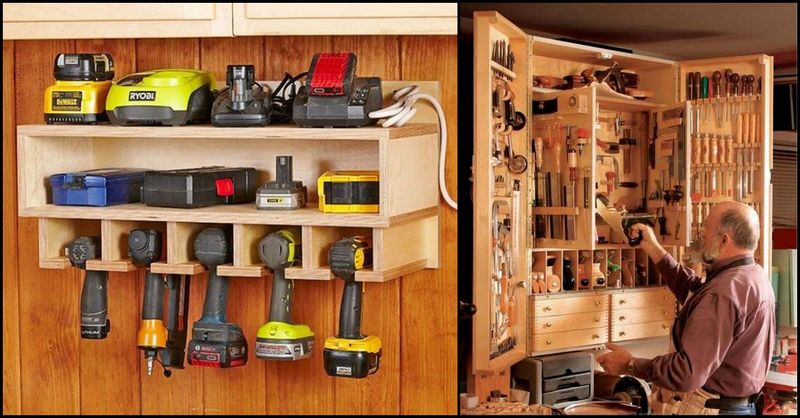
Most DIYers start with a few basic tools and a simple drawer, shelf, or pegboard wall for storage. As you improve your craft the number of tools you accumulate increases, and in turn, demands an efficient storage system.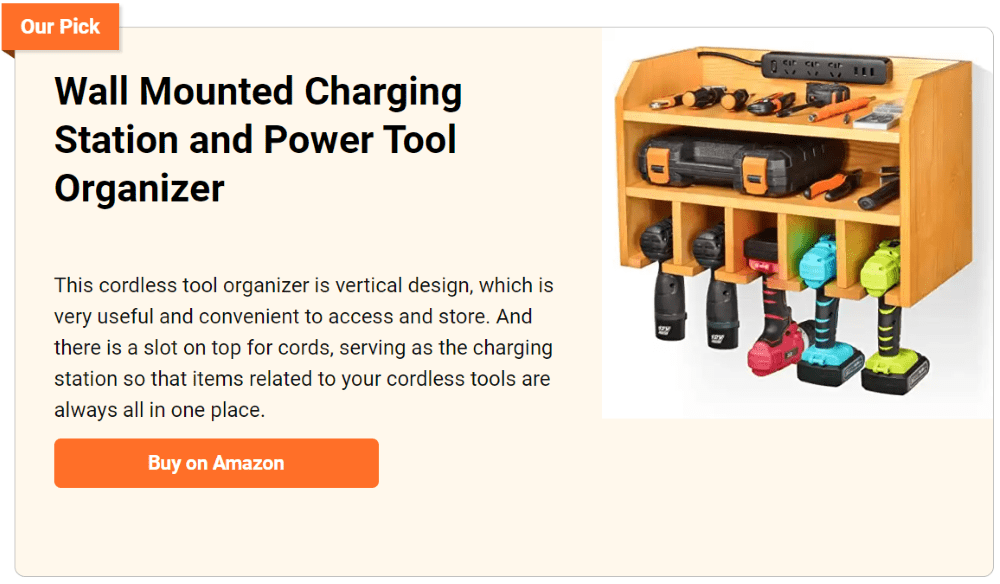
An efficient tool storage system is one that allows you to access your most often used tools – and even the less frequently used ones, without the need to take out other tools.
One of the secrets of a safe and efficient workshop is an organized and accessible tool storage system.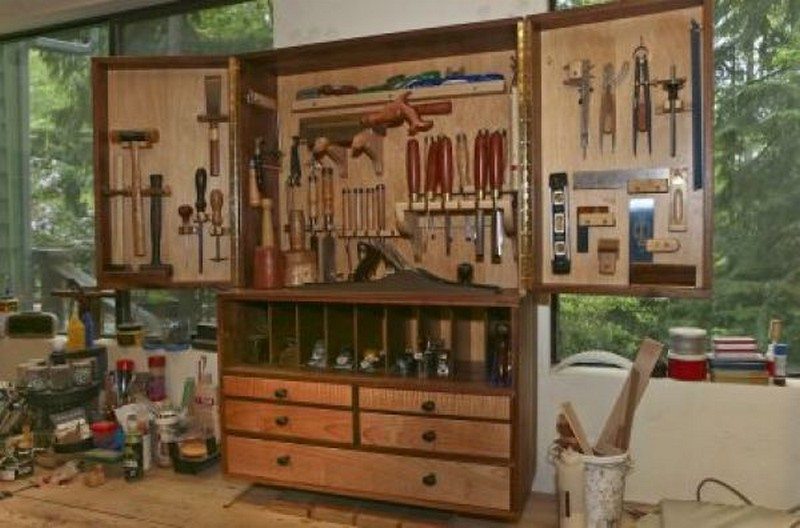
If you need clever ideas on how to organize and store the tools in your workshop, then this album is for you!
Click on any image to start the lightbox display. Use your Esc key to close the lightbox. You can also view the images as a slideshow if you prefer 😎
List of Tool Storage Ideas
In any workshop, organizing tools efficiently is key to a smooth workflow. Whether you’re a DIY enthusiast or a professional, the right storage solution can make all the difference. Here are some innovative ideas to keep your tools well-organized and easily accessible.
Maximizing Space in Small Workshops
In small workshops, space is a premium. Making the most of every inch is crucial. This section focuses on innovative ways to maximize space without compromising functionality. First, consider vertical storage solutions. Wall-mounted racks, pegboards, and magnetic strips can hold tools off the floor, freeing up valuable workspace.
Next, think about fold-away features. Workbenches and shelves that can be folded against the wall when not in use are great space-savers. Lastly, use the ceiling. Overhead storage racks are perfect for items that aren’t frequently used. By utilizing vertical space and fold-away furniture, you can transform a cramped workshop into a versatile and organized workspace.
Security Measures for Tool Storage
Security is vital when it comes to tool storage. Protecting your tools from theft and misuse is as important as organizing them. Start with lockable storage options. Whether it’s a cabinet, toolbox, or drawer, having a lock ensures that your tools stay safe. Consider installing a security system or cameras in your workshop for added protection.
Additionally, tool tracking systems are useful, especially for expensive items. They can be as simple as a sign-out sheet or as sophisticated as RFID tags. For shared or public workspaces, implementing user authentication systems on tool cabinets can prevent unauthorized access. Keeping your tools secure not only protects your investment but also ensures that they are there when you need them.
Eco-friendly Tool Storage Solutions
Eco-friendliness is becoming increasingly important in every aspect of our lives, including how we store our tools. This section explores sustainable practices in tool storage.
Start with materials. Opt for storage solutions made from recycled or sustainable materials. Reclaimed wood, recycled metal, and biodegradable plastics are great choices. They reduce environmental impact without sacrificing durability.
Another aspect is the manufacturing process. Choose brands that follow eco-friendly practices. This includes using renewable energy sources and minimizing waste during production. Lastly, consider the lifespan of your storage solution.
Durable, high-quality options may be more expensive initially, but they last longer, reducing waste and the need for frequent replacements. By choosing eco-friendly tool storage, you contribute to a healthier planet while keeping your tools organized.
Tool Storage for Mobile Workshops
For professionals and hobbyists who travel with their tools, mobile storage solutions are essential. This section covers how to keep your tools organized on the go. First, focus on portability. Look for toolboxes and storage systems that are easy to transport. This could mean lightweight materials, compact designs, or wheels for easy movement.
Next, consider modularity. Modular storage systems can be reconfigured to fit different tools and workspaces, making them ideal for mobile workshops. They allow you to adapt your storage to the specific needs of each job. Durability is also key.
Mobile storage solutions should withstand the rigors of travel. Look for impact-resistant materials and sturdy construction. Organizing your mobile workshop effectively means you can focus on the job at hand, knowing that your tools are safe, secure, and exactly where you need them.
Technology Integration in Tool Storage
Incorporating technology into tool storage is revolutionizing how we organize and access our tools. This section delves into ways technology can enhance tool storage efficiency. Smart storage systems are a significant development. They can include features like automated drawers that open with a voice command or a touch and LED lighting that illuminates the tool you need. Inventory management is another area where technology plays a vital role.
Digital tracking systems, often app-based, can keep a real-time inventory of your tools, alerting you when a tool is missing or needs maintenance. RFID technology can also be integrated for quick tool tracking and management. By embracing these technological advancements, tool storage becomes more efficient, saving time and reducing the frustration of misplaced tools.
Ergonomic Tool Storage Design
Ergonomics plays a crucial role in tool storage design, focusing on minimizing physical strain and maximizing efficiency. This section highlights key considerations in ergonomic tool storage design. Height and reach are vital factors. Tools should be stored at a height that avoids the need for excessive bending or stretching.
Drawers and shelves should be easily accessible, with frequently used tools placed at waist level. The layout is also important. Organize your tools in a way that follows the natural workflow. This means placing them in the order they are typically used, reducing the need to search for them.
Comfort is another aspect. Handles and grips on storage units should be designed for comfortable use, especially if they are moved frequently. An ergonomic tool storage system not only makes your workshop more efficient but also helps in reducing the risk of injury, making your crafting experience more enjoyable and productive.
Customization Options in Tool Storage
Customization in tool storage allows for a system that perfectly fits your specific needs and preferences. This section explores various ways to personalize your tool storage. Start with modular systems. These systems can be rearranged or expanded, adapting to your changing tool collection. Y
ou can choose different sizes and shapes of drawers, racks, and shelves to create a layout that suits your workflow. Next, consider DIY solutions. Building your own storage units allows for complete control over the design.
Use materials like wood or metal to create custom shelving, cabinets, or pegboards. Decorative elements can also be added. Paint, decals, and unique hardware can give your tool storage a personal touch. Customization not only makes your workspace more efficient but also reflects your style and creativity.
Tool Maintenance and Storage
Proper storage plays a crucial role in tool maintenance. This section covers best practices for storing tools to prolong their lifespan. First, consider the environment. Tools should be stored in a dry, clean, and temperature-controlled space to prevent rust and degradation. Silica gel packs can be used to absorb moisture in the storage area.
Next, organization is key. Arrange tools in a way that prevents them from knocking into each other, which can cause damage. For sharp tools like chisels or saw blades, protective sheaths or holders will prevent them from becoming blunt.
Finally, regular cleaning and oiling of tools before storage can prevent rust and ensure they remain in good condition. Proper maintenance and storage not only extend the life of your tools but also ensure they’re ready and in optimal condition for your next project.
Budget-Friendly Tool Storage Ideas
Organizing your tools doesn’t have to break the bank. This section offers budget-friendly tool storage ideas that are both practical and cost-effective. Start by repurposing household items. Old cabinets, shelves, or even jars can be transformed into useful storage solutions.
DIY projects are another great way to save money. Building your own tool racks, pegboards, or storage boxes from affordable materials like wood or recycled goods can be a cost-efficient alternative. Look for sales or second-hand deals on storage units.
Often, you can find high-quality items at a fraction of the original price. By being resourceful and creative, you can develop effective tool storage solutions without spending a lot, ensuring your tools are well-organized and easily accessible.
Tool Storage Trends and Innovations
The world of tool storage is constantly evolving with new trends and innovations. This section highlights the latest developments in tool storage, focusing on how these advancements can benefit your workspace. Modular and customizable storage systems are becoming increasingly popular, offering flexibility and adaptability to different tools and spaces.
Smart storage solutions, integrated with technology like IoT devices and apps, are on the rise. They offer features like automated inventory tracking and security alerts. Eco-friendly materials and sustainable practices are also gaining traction in tool storage design, appealing to environmentally conscious consumers.
Lastly, compact and mobile storage solutions are becoming more sophisticated, catering to the needs of users who require portability without compromising on storage capacity. Staying abreast of these trends and innovations ensures your tool storage is not only efficient but also aligned with the latest advancements in the field.
What to consider when building an efficient Tool Storage?
Type of Tools
The first thing you need to consider when you build storage for your tools is to identify the type of tools that you have.
There are lots of types of tools, you may want to consider arranging them based on their usage. You can separate hand tools, testing tools, electric or cordless tools, etc.
It is important to arrange them accordingly so that you will know the size (height, width, length) of the storage that you will be building.
With this, you can make sure that every tool, will be stored in its particular spot. You can easily track the tools that are not returned to the storage at the end of the day.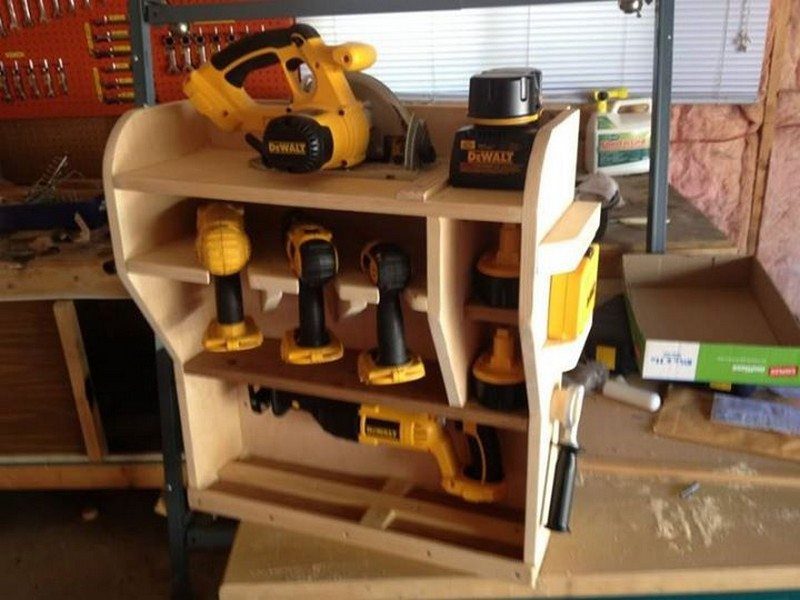
Tools Compartments
If you have already arranged the tools according to their type, and you were able to get the correct measurements for tool storage size, then you will now have to create the compartments for your tool storage.
Tools compartments should fit the types of tools you have to store and it will determine the overall appearance of your tool storage system.
The tools compartments will look different based on what types of tools they are holding. If the compartments are designed to hold wrenches and screwdrivers, they should be sized accordingly so that the wrenches and screwdrivers will fit inside.
The tool compartments should also be designed to hold the most common sizes of each tool you store. This will help to ensure that you can find the tools you have when you need them.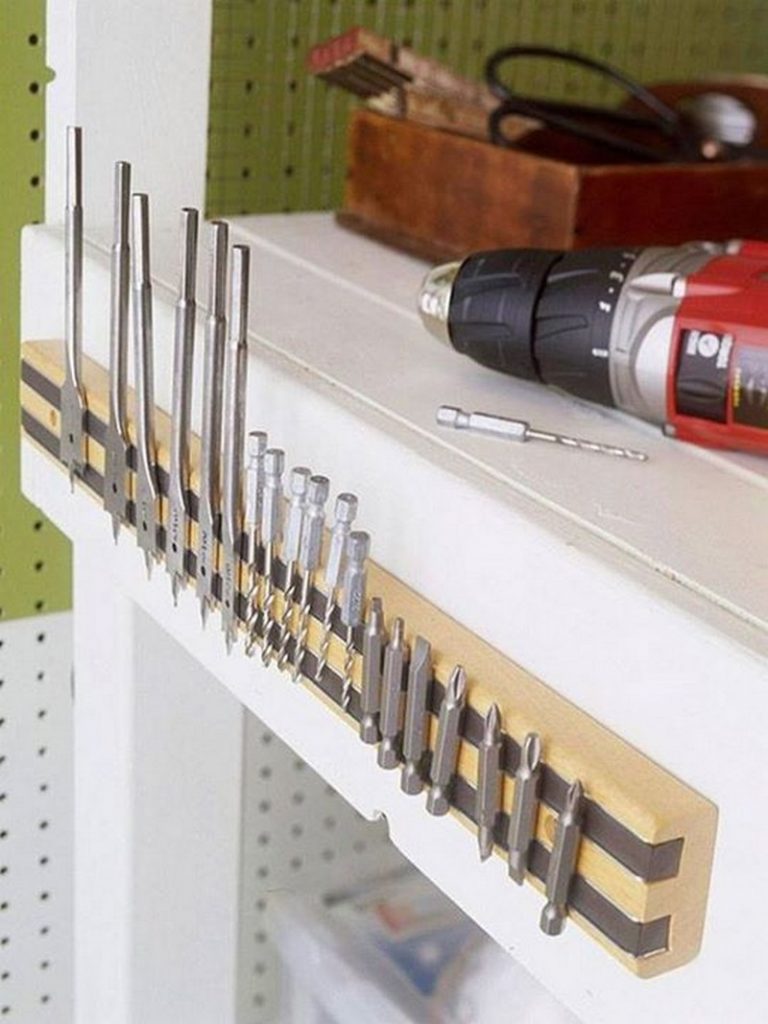
Materials
Each compartment will need different materials according to what type of tools you’re going to store. For instance, in creating tool storage for bullet screwdriver bit sets, you may want to consider adding magnets to the compartments. In this case, the screwdriver bits will be secured in their proper places because of the magnets.
Materials are important when building a tool storage cabinet. You will have to consider the aesthetics, budget, and weight of the material you choose.
Wood should be your first choice as it’s very easy to work with. The downside is that it can be slightly expensive, heavy, and tends to warp. It is also not the best option for areas that are humid and subject to moisture.
Metal tool storage cabinets are another good choice. Metal is a great option because it is lightweight, very durable, and doesn’t warp. It is also more rust-resistant. The downside is that metal is a bit more difficult to work with. You will need to use a metal saw to cut it, and some tools can be expensive.
Plastic tool storage cabinets are also a good choice for anyone that is like most of us and don’t store all of their tools in one place. They can be stacked on top of one another or you can put a couple of them on their side to make a unit that can be tucked away in a closet.
Plastic tool cabinets are also a good choice for anyone that has kids or pets and doesn’t want their tools getting damaged by someone opening and closing the drawers.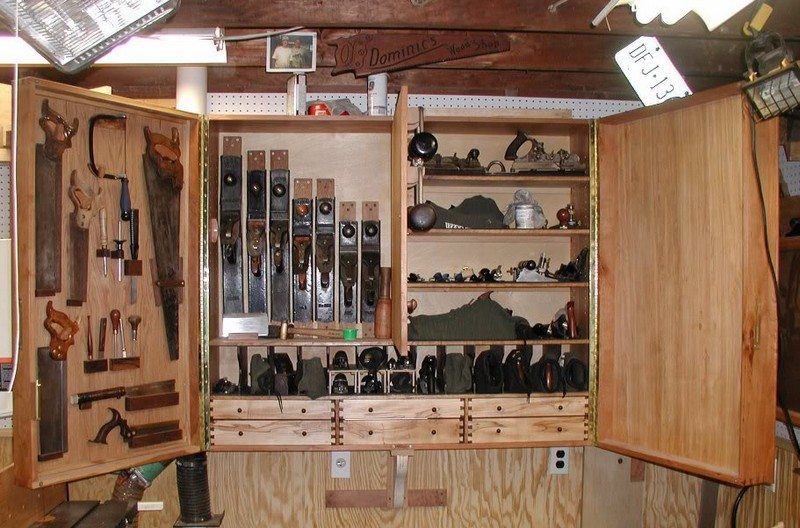

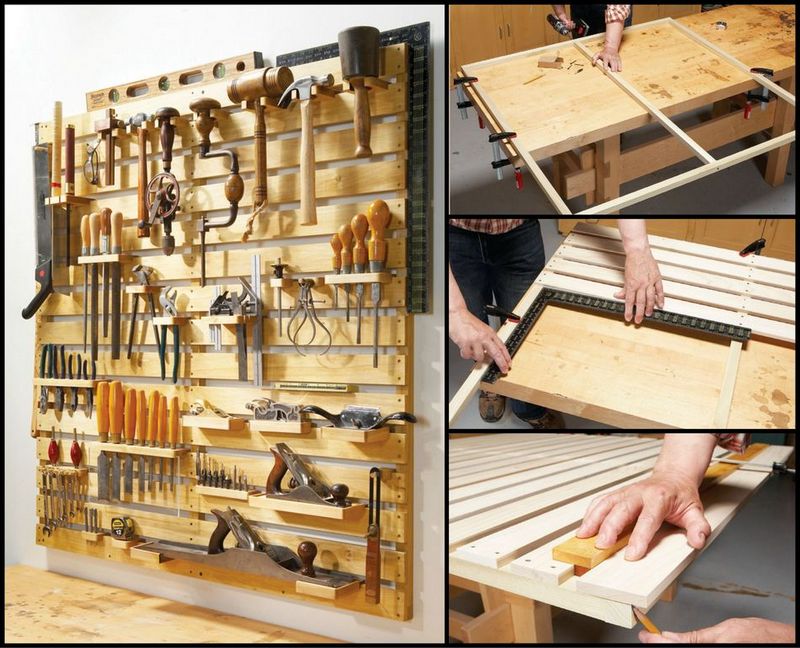

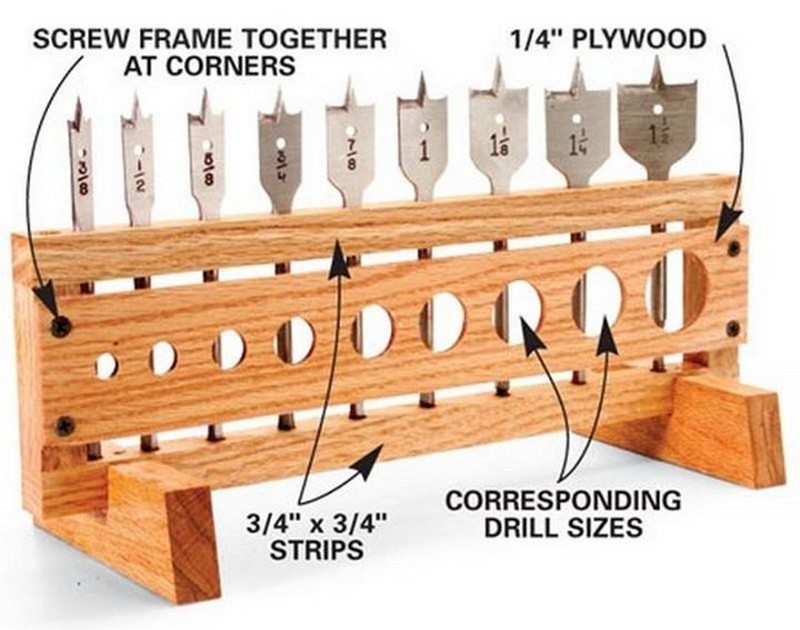
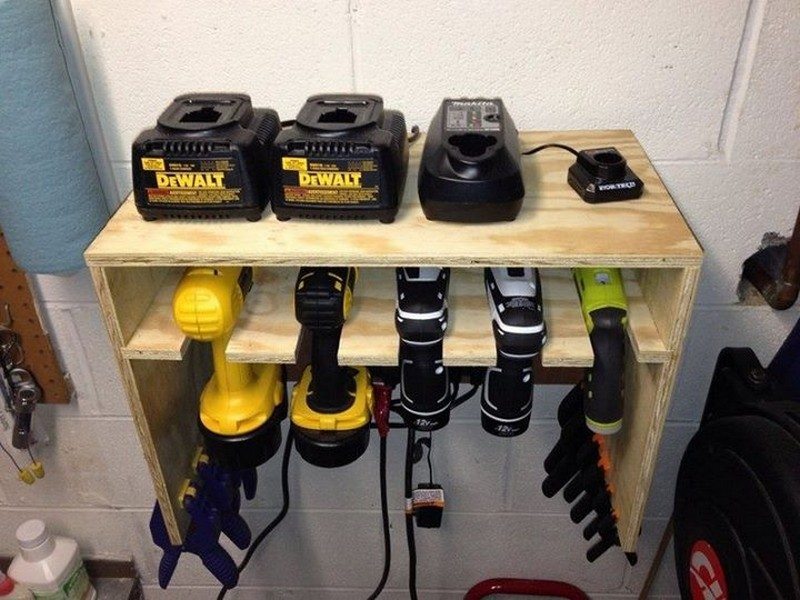
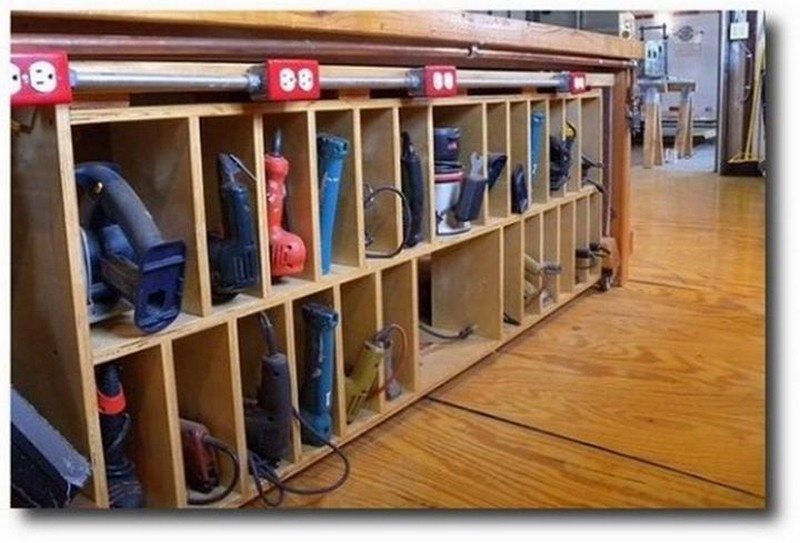

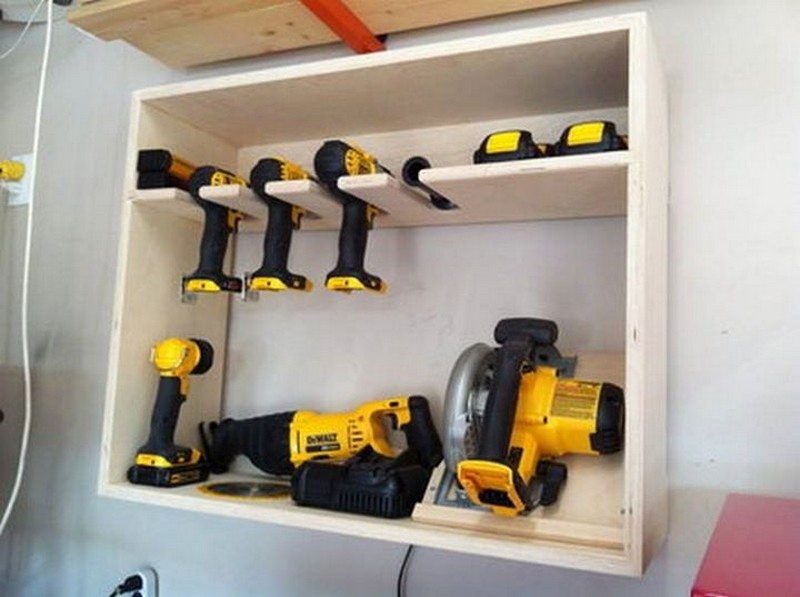

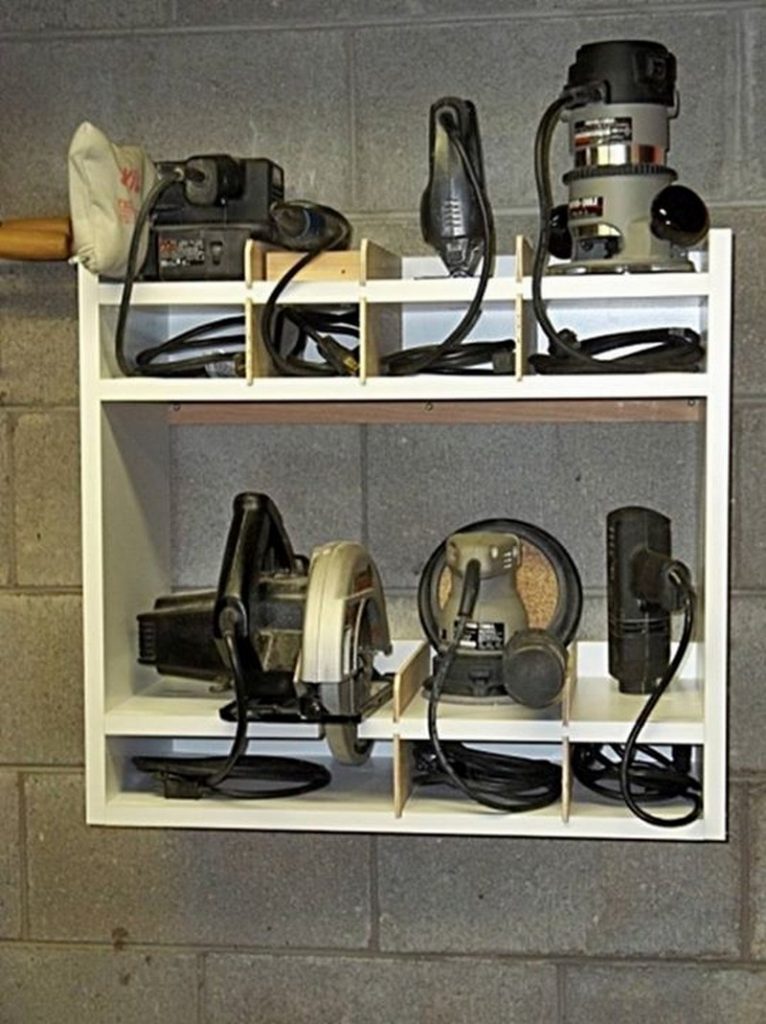

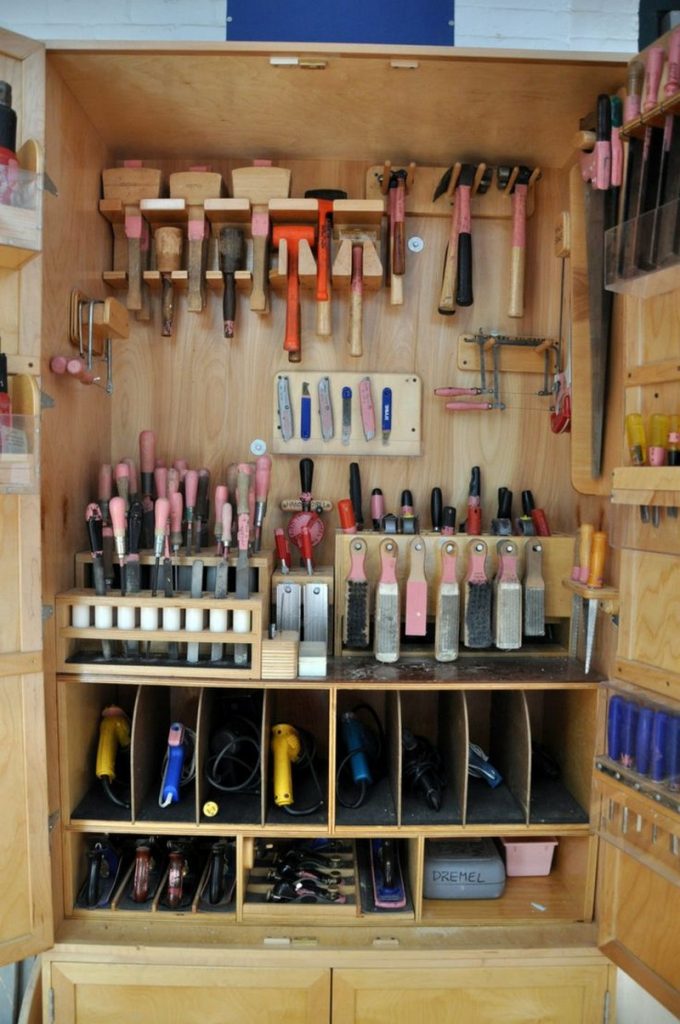
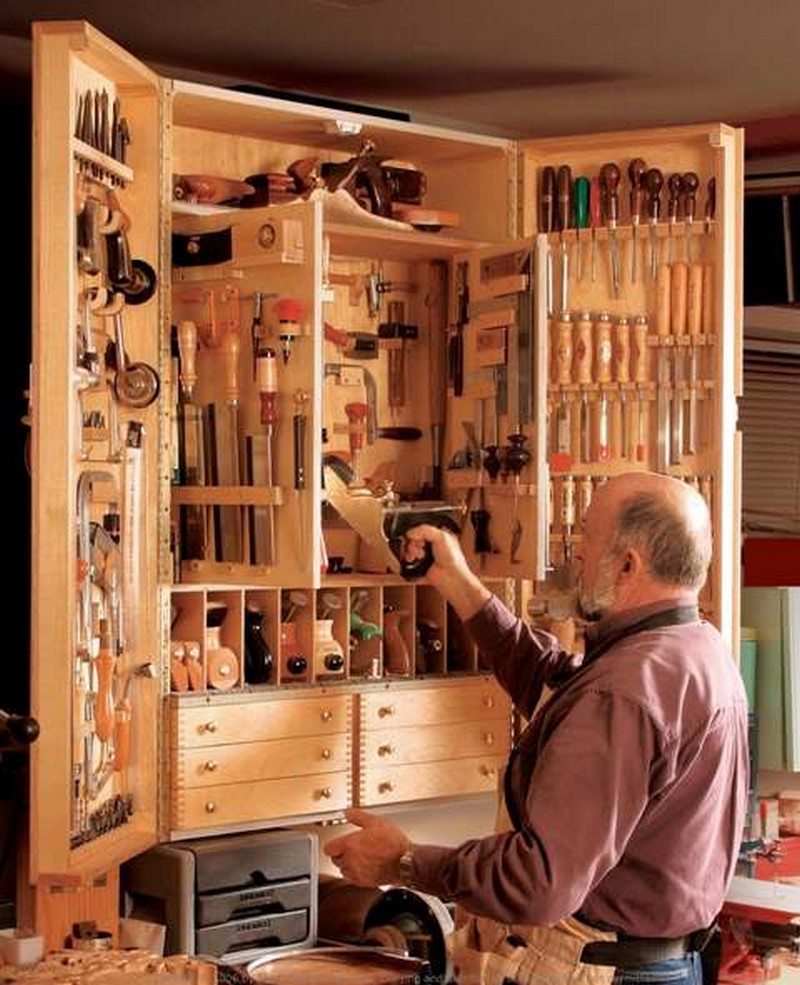
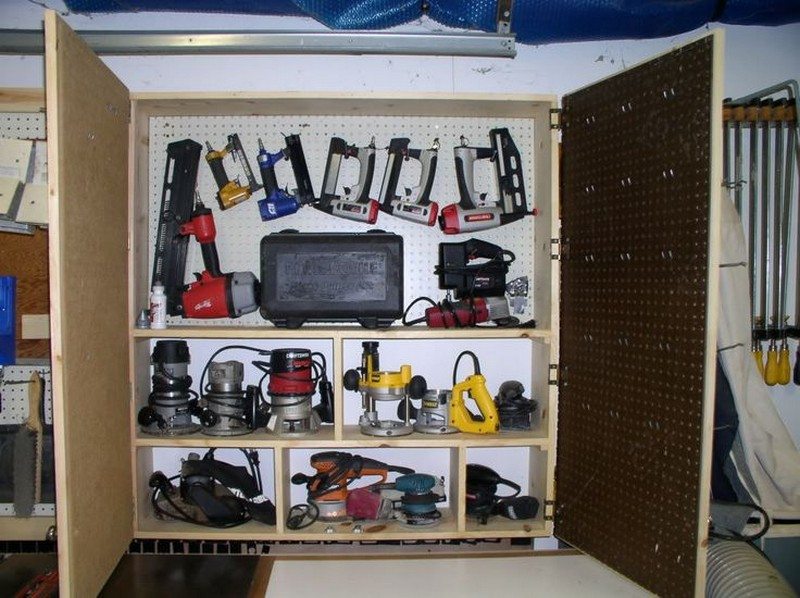
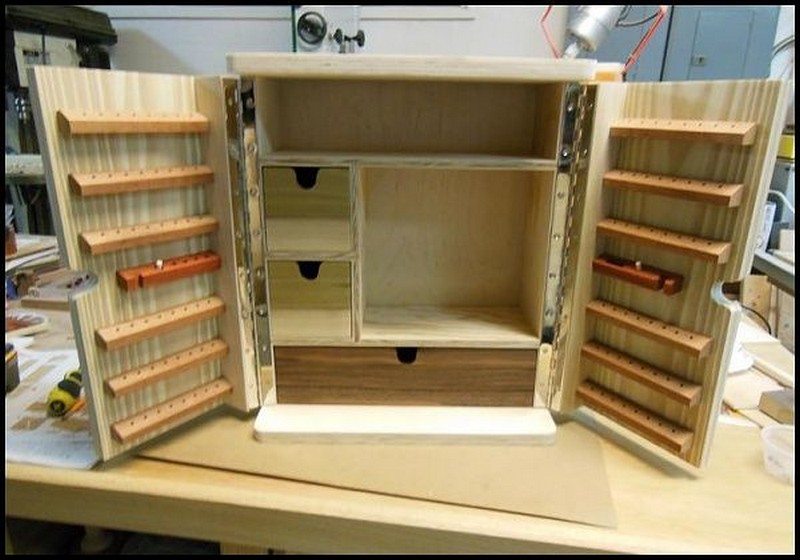

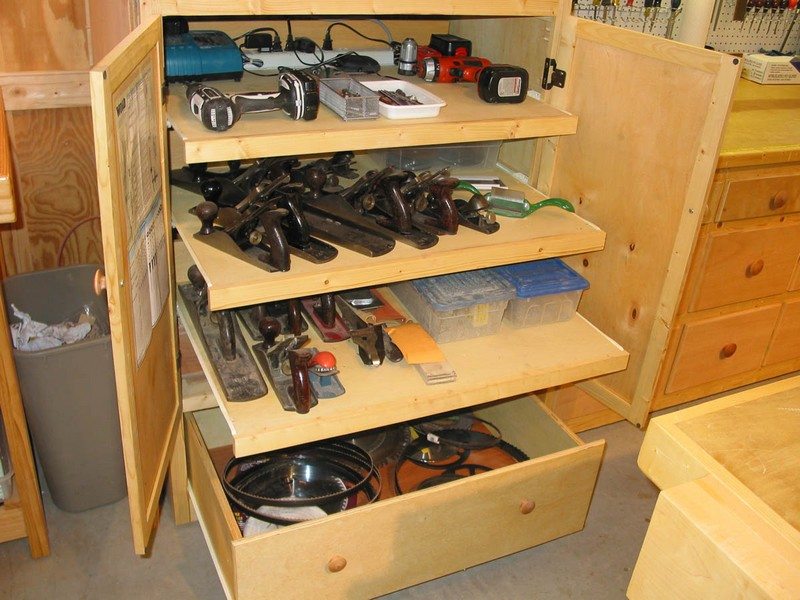

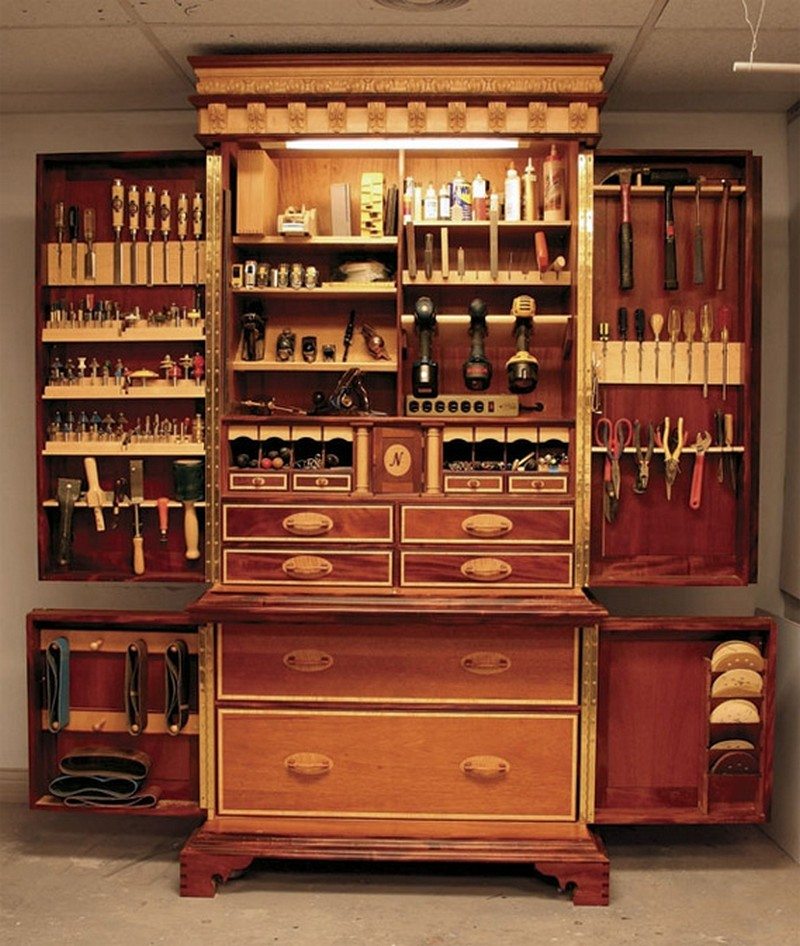
Tool Storage Maintenance Tips
Maintaining your tool storage system is crucial for ensuring longevity and efficiency. Proper care keeps your storage solutions in good condition, protecting your tools and making them easily accessible when you need them. Here are some essential tips for maintaining your tool storage.
Regular Cleaning
Keep your tool storage clean to prevent dust and debris accumulation. Regularly wipe down shelves, drawers, and cabinets. For metal surfaces, use a mild detergent and for wooden parts, a suitable wood cleaner. This not only maintains cleanliness but also helps in spotting any potential issues like rust or wood rot early.
Check for Damages
Inspect your storage system periodically for any signs of wear and tear. Look for loose hinges, rusty handles, or worn-out drawers. Addressing these issues promptly prevents further damage and ensures the safety and functionality of your storage system.
Lubricate Moving Parts
Toolboxes and storage cabinets often have moving parts like drawers and wheels. Regularly lubricating these parts ensures smooth operation and prevents them from getting stuck or squeaky.
Monitor for Moisture
Moisture can be detrimental, especially to metal and wooden storage systems. Use dehumidifiers or silica gel packs in your storage area to keep moisture levels low. This helps prevent rust and wood warping, extending the life of your tool storage.
Organize Regularly
Regularly reorganize your tools and storage setup. This not only helps in keeping your tools in the right place but also gives you a chance to assess the condition of both the tools and the storage system. It ensures that everything remains accessible and in good working order.
FAQ on Tool Storage Ideas
How can I organize my tools with limited space?
What are the best materials for eco-friendly tool storage?
How do I keep my tools secure in my workshop?
What are some budget-friendly tool storage ideas?
How can technology improve my tool storage?
What should I consider for ergonomic tool storage?
Can I customize my tool storage?
How do I maintain my tools in storage?
Are there any new trends in tool storage?
What’s the best way to store tools for mobile workshops?
Conclusion
Our guide on functional tool storage ideas shows that with the right strategies, you can create an efficient, secure, and organized space for your tools. From embracing eco-friendly materials to integrating the latest technologies, there are options to suit every need and budget. Customizable solutions and ergonomic designs ensure that your workspace is not only practical but also comfortable.
If you liked these, you will also like viewing these storage ideas…






